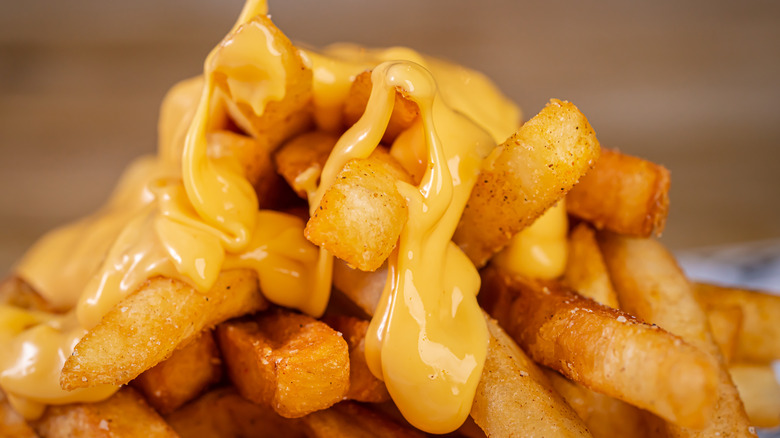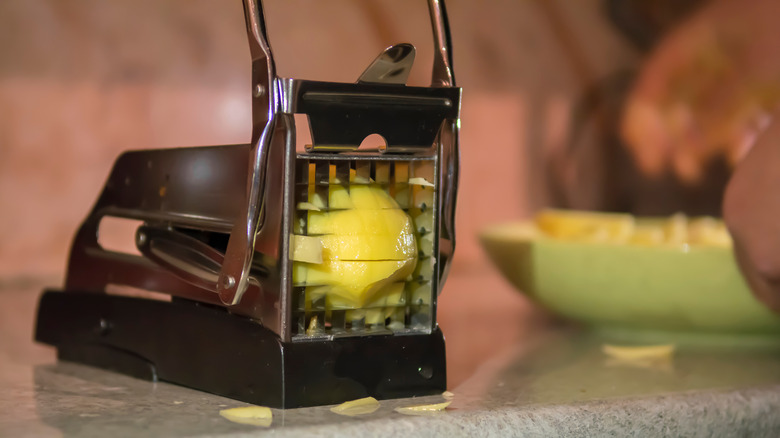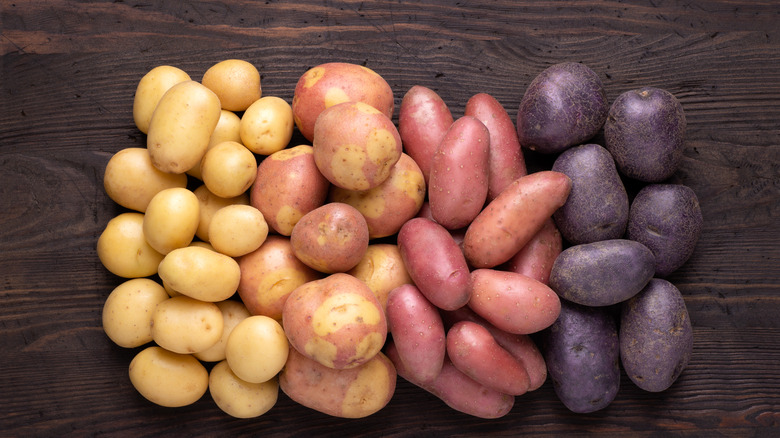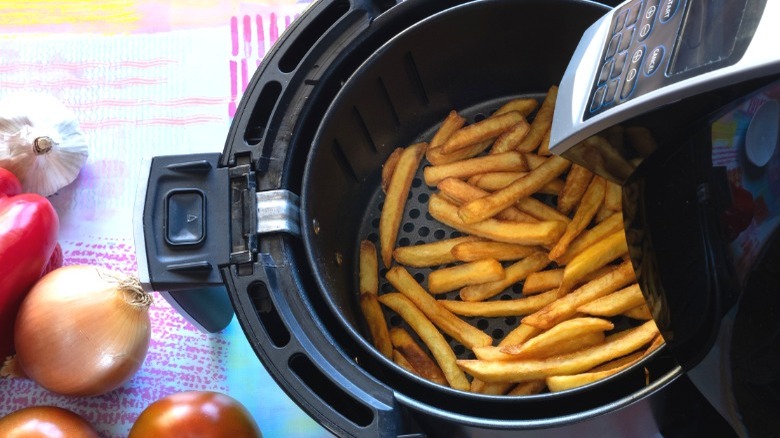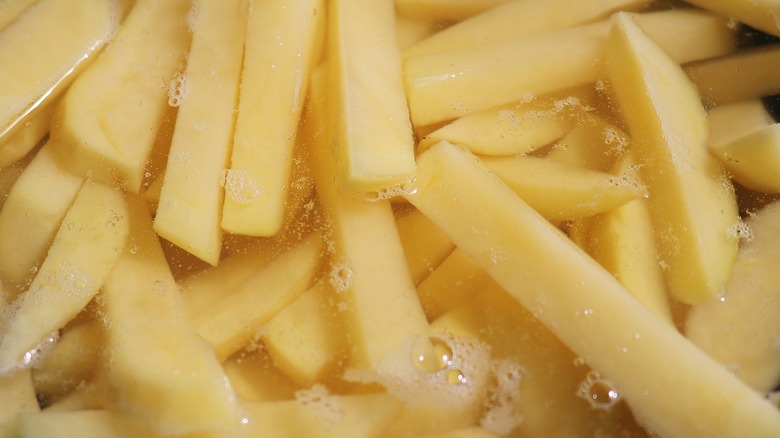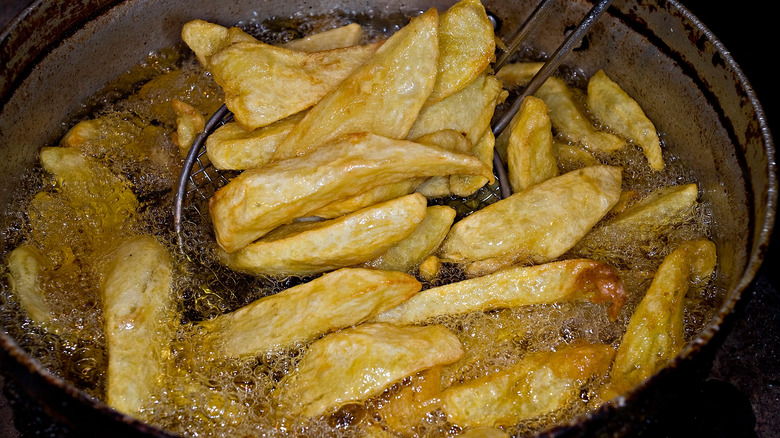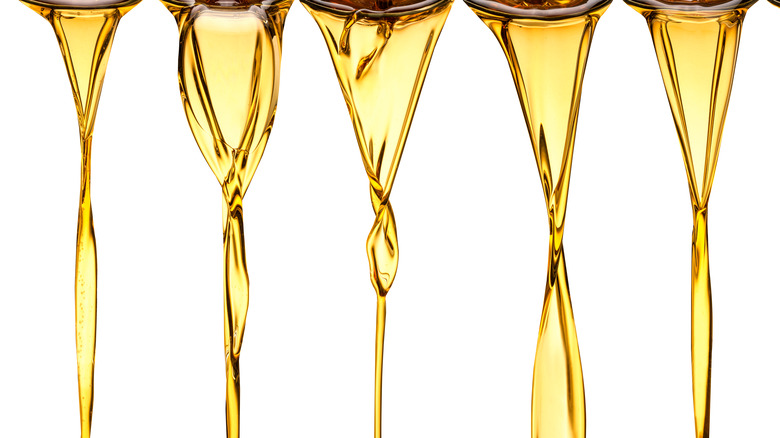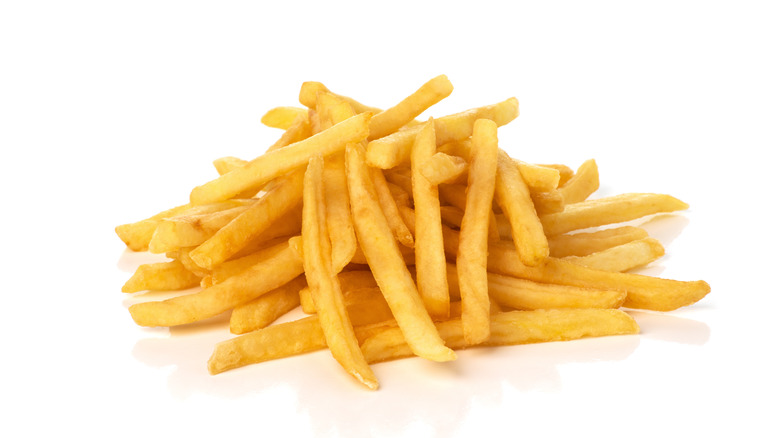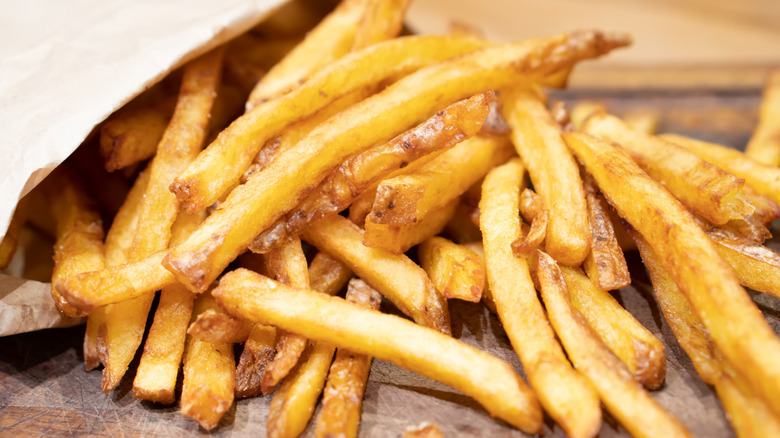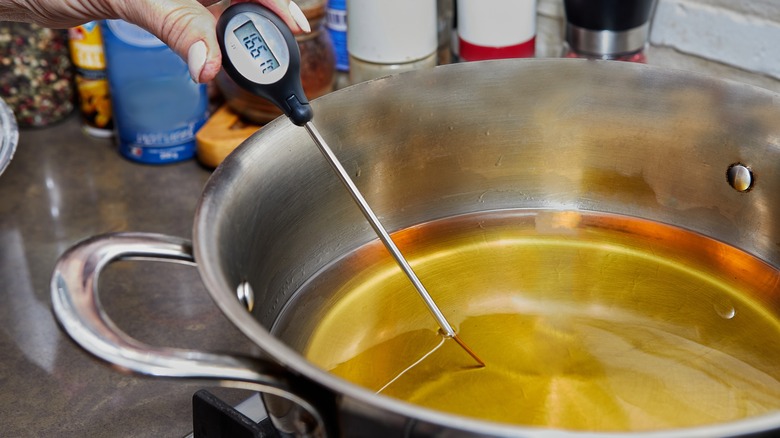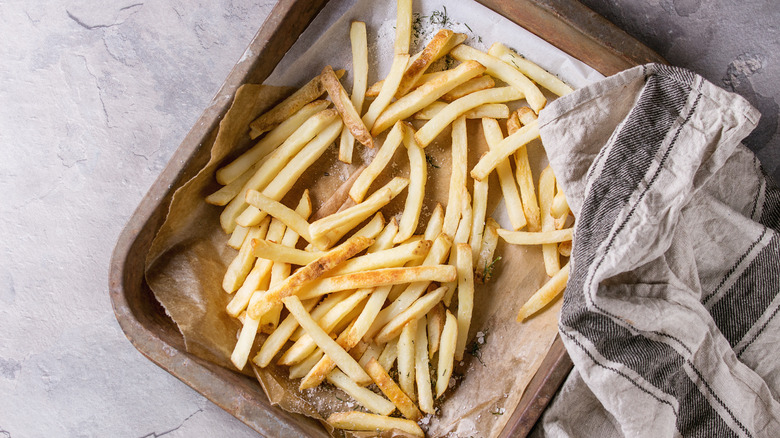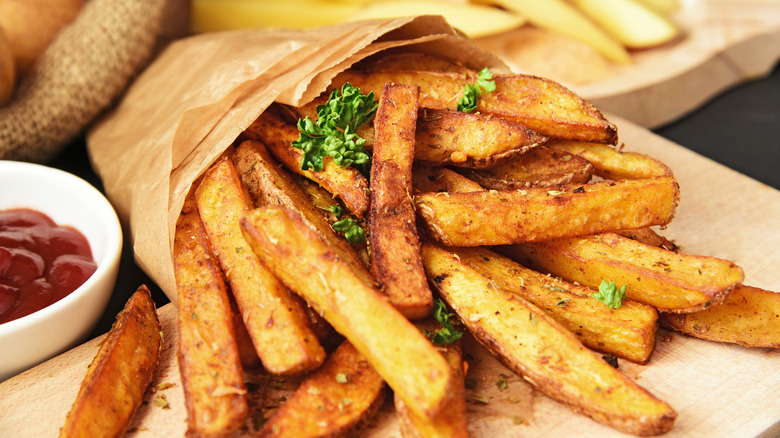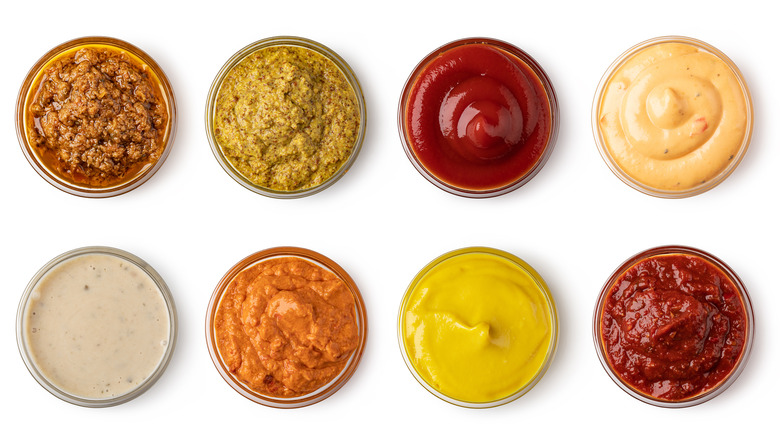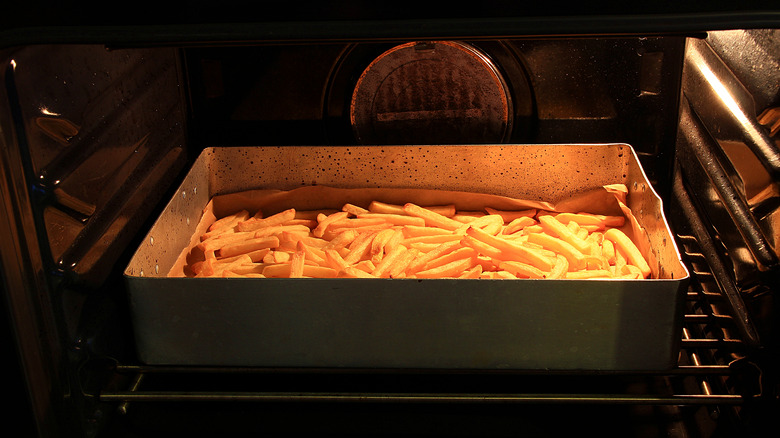13 Tips For Making Better French Fries At Home
French fries are a classic American side dish commonly served with fried seafood, burgers, and sandwiches. These potato sticks are fried in oil until golden brown. The fries are then usually seasoned with salt and served with a dipping sauce. French fries can also be a base for more complicated dishes like poutine, disco fries, and cheese fries. French fries come in an array of shapes and sizes, including hefty steak fries, thin shoestring fries, seasoned curly fries, and the illusive smiley-face fry.
Although french fries might appear easy to recreate in your home kitchen, cooking french fries at home requires both manual dexterity and the knowledge of how to prepare fried food properly. Luckily, we have all of the important stuff covered. Here are some of the simplest ways to make better french fries from scratch — almost all of which are simple enough to implement in a matter of minutes.
Use a french fry cutter for uniform fries
First and foremost, it is important to make sure your fries are cut to the same shape and size. This will ensure that the fries cook at the same rate and yield the same crispy result. We recommend purchasing a french fry cutter for easy slicing. For some models like the Sopito Professional, you won't even have to half or quarter your potatoes before inserting the potato into the machine. For thinly sliced round fries, use a mandoline.
If you don't have access to a slicer or a mandoline, you can slice these potatoes with a cheese planer or vegetable peeler. Both devices are more tedious than a mandoline but yield the same thin slices. You can also use a food processor with a slicing attachment, but Baking Kneads notes that you will have less control over the size of the slices than if you were to use a hand-held device.
Avoid waxy potatoes
Not all potatoes are created equal. The perfect crisp-on-the-outside-smooth-on-the-inside french fry potato is a starchy variety. Russets are one of the most popular types of potatoes used for frying because they have a low-moisture content and are relatively robust. Yukon Golds are another frying potato frequently found in American grocery stores. While Yukon Gold is an all-purpose potato, it has a slightly waxier texture than the russet. These varieties are also often used for french fries due to their size. Using a large, oblong potato makes peeling, slicing, and frying the fries easier than if you were to use a smaller and more round potato.
Avoid frying waxy potato types like fingerling, red thumb, and purple majesty. Not only do these lack the starchiness needed for the perfect fry, but the potatoes are also too waxy to get a crunchy fry. Save these varieties for roasting and potato salads instead of frying.
Make french fries in your air fryer
On a hot summer day, you likely don't want to turn on your oven or start a deep-frying set-up. Instead, you can turn to your trusty air fryer for french fries. After slicing and soaking the potatoes, toss the fries in a blend of oil, salt, and pepper.
Although you may want to spray the inside air fryer basket with cooking oil, try to refrain. Many air fryer baskets already have a nonstick coating and can be difficult to clean with an additional layer of oil. The oil on the fries should be enough, though you can add a spritz of oil halfway through cooking to prevent sticking and create crispier fries if needed.
Once your fries are ready to be cooked, set the temperature to 380 F. It's important to use a single layer in the fryer basket. Since air fryers work in convection currents, adequate space in the basket ensures that the air can circulate and evenly cook the fries (via U.S. News & World Report). After eight minutes, shake the fries vigorously before cooking for another seven minutes. For browner fries, try adding another three to five minutes in the air fryer before serving. Leftover fries can be heated up at the same temperature for two to three minutes before serving.
Soak sliced potatoes in water
Soaking potatoes in water for at least an hour is one of the simplest things you can do for crispy fries that don't stick together. According to chef Riad Nasr, soaking draws the starch out of the potato and increases its rigidity (as reported in The New York Times). Marketing and research firm, Potatoes USA, advises home cooks to soak spuds in cold water rather than hot water to avoid activating the starch. And, according to experiments at Food Crumbles, you'll know the fries are ready to cook once the water is cloudy and murky.
It is important to make sure your fries are as dry as possible before frying to avoid sputtering in the oil. One easy way to remove the water from your potatoes post-soak is to pop the sticks into a salad spinner. You can also rub the potatoes in a lint-free kitchen towel or a paper towel to remove excess moisture.
Fry in batches
The key to a crispy batch of fries is an even cook, so it's best to fry in batches. When you add too many fries to the oil, the temperature drops dramatically, altering the quality of the fries. Food Above Gold suggests starting the frying temperature at 375 F to account for changes once the fries are dropped in. You should always have a cooking thermometer handy to test the oil temperature throughout the frying process and add more heat if the temperature dips too far down.
It is also important to remember that the shape of your pot dictates how much oil (and how many fries) can be cooked at any one time. Wide, shallow pots are more ideal than tall, deep pots because there is more surface area for the fries to cook. We recommend frying in a Dutch oven; it retains heat well, is easy to clean, and spacious enough to fry large batches of oil.
Select the right kind of oil
According to Food Above Gold, the perfect fry oil has a high smoke point, which means that the oil will not emit burnt notes at high temperatures. When looking for the perfect deep-frying oil, you want an oil that has a smoke point above 400 F. Peanut oil is the classic french fry choice (it's used by chains like Five Guys, according to the company's website), but neutral-flavored oils like vegetable, canola, avocado, and sunflower oils can also be used.
For a boost of flavor, try using beef tallow for your french fries. Beef tallow is made from rendered fat that has been cooked down to remove most of its impurities. Like other neutral cooking oils, beef tallow has a high smoke point at around 400 F. It has a solid consistency similar to butter and melts when heat is applied. The beef tallow infuses a salty, umami flavor into french fries that you can't get from conventional frying oil.
Remove moisture by frying twice
Double-frying is commonly noted as the best way to remove moisture in french fries. Webstaurant Store recommends first blanching soaked potatoes for between three and six minutes at 325 F — the exact time depends on the width of the fry. For instance, shoestring fries are less than 1/8-inch thick and only need to cook for about a minute, while steak fries (ranging between 3/8- and 1/2-inch thick) must cook between four and six minutes. Regardless, you'll know the potatoes are cooked enough when you can bend the fry without breaking it.
The second round of frying is completed at a higher temperature: around 375 F for two to three minutes. This session is not made to actually cook the potatoes but merely provides a crispy brown exterior. You'll know they're finished and ready to season when the fries come out of the fryer golden brown.
Fry potatoes with the skin on, but clean them well
The added nutritional benefits of eating potato skin is debatable (via American Journal of Potato Research). Yet, leaving the skin on french fries creates a more rustic appearance and crunchy texture than skinless fries. As an added bonus, it requires less prep time. When you choose this route, it is especially important to clean the potatoes well before cutting them into fries.
The Colorado State Department of Public Health and the Environment notes that potatoes can harbor soil bacteria and pesticides, so it is especially important to get into all the nooks and crannies of these tubers. You can wash potatoes by hand using a few simple methods, such as a vegetable scrubber, exfoliating gloves, or a kitchen towel, and rub the potato in circular motions. Rinse with cool or lukewarm water to remove any dirt pockets, followed by a rigorous drying process.
Avoid making the oil too hot
You're running out of time to make your perfect french fries at home. What's the natural thing to do? Heat the oil at the highest possible temperature and drop the fries in to cook the potatoes as fast as possible, right? Per FryMax, dumping french fries in a vat of overheated oil doesn't just lead to a dangerous situation of hot spattering oil, but it also means the fries cannot cook effectively. Frying is a delicate balance of heating the outside of the fry to the point where it gets crispy but not burned and cooking the inside so it is not overcooked.
If you're cooking on a time crunch, Food Crumbles recommends cutting the fries to the shortest dimension possible. Short, thin fries cook the fastest because the heat is able to reach the center of the fry faster than a long steak fry. You can also try making curly fries; the cylindrical shape is ideal for allowing heat to penetrate and cook the center of the fry.
Avoid leaving fries on a paper towel
You might have fond memories of your parent tossing fries from the stove onto a plate covered in paper towels. Although this strategy works to dry up excess oil, you may find tiny flecks of paper towel left on your pile of fries. Plus, it can make the fries soggy.
Instead, you'll want to place the fries on a surface that prevents steam from being trapped underneath, per Kosher.com. Using a cooling rack instead allows air to circulate around the fries — keeping the fries fresh and crisp. To prevent oil from dripping onto your kitchen counter, first line the counter with a layer of aluminum foil. You'll want to add a lip to all of the edges of the tin foil; this will prevent the oil from running off once you pull the aluminum out from underneath. This trick works for almost all fried food, including chicken and seafood.
Use seasonings besides salt and pepper
Seasonings should always be applied to the fries after cooking (except when using an air fryer) because salt will explode in hot oil. Minimizing the post-fry period is also important because the seasonings will only stick to the potato when it's hot and oily.
You can get creative when it comes to seasonings. Old Bay is a blend of celery seed, pepper, and paprika that tastes great when paired with flaky sea salt on a french fry. You can also utilize fresh herbs like dried rosemary, herbs de Provence, and parsley for an Italian spin on your fries.
If you're looking for more extravagant fries, you might consider making truffle fries with grated Parmesan cheese. Chef Billy Parisi recommends using a scant amount of white truffle oil — typically made by infusing white truffle into a neutral oil, such as canola or vegetable oil — for french fries. A little bit of white truffle oil goes a long way, so use only 1/4 cup of oil for four to six russet potatoes.
Make your own dipping sauce
Dipping sauce is the perfect way to make a boring french fry exciting. A homemade garlic aioli is a mayonnaise-based condiment made from simple ingredients like garlic, lemon, oil, and ground pepper. It comes together in under three minutes and is perfect when dipped with salty french fries.
If you're feeling more like a traditional, tomato-based condiment, make your own homemade spicy ketchup by combining your favorite store-bought ketchup, hot sauce, and spices. You can tailor the spiciness to your liking while also adding flavorful additions like garlic and onion powder.
Cheese sauce is another popular addition to french fries. Cooper Cheese recommends making a thick roux in a saucepan before adding sharp cheese. The roux ensures the cheese mix is thick and sticks to the fries once it's finished. After the fries are served with cheese, you can also add chopped green onions or homemade chili toppings.
Eat your fries before they get too cold
French fries delivered to your door in a brown paper bag don't stay fresh for long. The same can happen to your homemade fries if you're not careful. Granted, not everyone can eat french fries super-fast, so there are some methods of reheating fries that will result in a crisp fry every time.
If you're planning to reheat your french fries, ditch the microwave. The heat is uneven, and since the microwave heats from the inside out, your fries will be rendered soggy. Instead, preheat your oven to 450 F and bake your fries on a sturdy baking sheet. This method can reheat fries in under 10 minutes, depending on the size of the batch. If you'd rather reheat the fries on a stovetop, use two teaspoons of oil for every cup of fries in a large skillet. Cook for about a minute in sputtering oil before flipping and cooking the other side briefly.
While reheating fries seems like a logical thing to do, there are some instances where the fries are not safe to eat if left out for too long. The Food Safety and Information Service suggests that at temperatures below 90 F, french fries should be left out no more than two hours before they're thrown away (one hour above that temperature). A sealed container with hot fries should be discarded even sooner as the humidity and temperature are the perfect incubator for food-borne pathogens.
